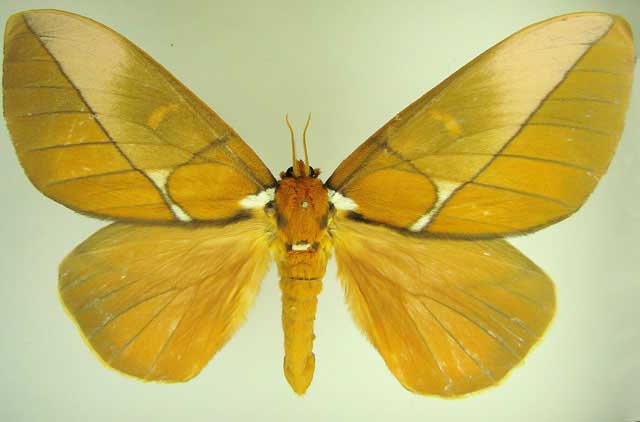Schausiella longispina
|
|
Updated as per Lemaire's Ceratocampinae 1988, September 25, 2006
|
Schausiella longispina
SHOU-zee-el-luhMlong-ih-SPYE-nuh
(W. Rothschild, 1907)
Othorene

Schausiella longispina pair, Iturralde (Bolivia),
T. DecaŽns & G. Lecourt
This site has been created by
Bill Oehlke at oehlkew@islandtelecom.com
Comments, suggestions and/or additional information are welcomed by Bill.
|
TAXONOMY:
Superfamily: Bombycoidea, Latreille, 1802
Family: Saturniidae, Boisduval, [1837] 1834
Subfamily: Ceratocampinae
was Syssphinginae, Packard, 1905
Genus: Schausiella, Bouvier, 1930
Species: longispina, (W. Rothschild, 1907) |
| MIDI MUSIC
"Wonderful.World"
copyright C. Odenkirk
MIDI CITY
ON.OFF
<bgsound src="world.mid" LOOP=FOREVER>
|
DISTRIBUTION:
The Schausiella longispina moth
(wingspan: males: 77-83mm; females: larger) flies in southeastern
Peru: Puno; Madre de Dios; and
Bolivia: La Paz; in tropical rain forest at elevations of 300 - 700 m.
The range is possibly more extensive than indicated.
Examination of genitalia is necessary to distinguish from polybia.

Schausiella polybia male, Yasuni National Park (Napo), Ecuador,
October 1, 2003, courtesy/copyright
Charles Bordelon and Ed Knudson

Schausiella polybia female, Yasuni National Park (Napo), Ecuador,
October 1, 2003, courtesy/copyright
Charles Bordelon and Ed Knudson
Please note that Claude Lemaire indicates male
S. polybia and male S. longispina can only be determined
by examination of genitalia. The female polybia displayed in
Lemaire's Ceratocampinae has a pm line much more preapical
than that displayed in the Charles Bordelon and Ed Knudson image above.
For that reason and for the geography of these two specimens, male and female,
I believe they are more likely Schausiella longispina, but recent publications, Entomo-Satsphingia 2013, indicate longispina is limited to
southeastern Peru and northwestern Bolivia.
FLIGHT TIMES AND PREFERRED FOOD PLANTS:
Schausiella
longispina moths are on the wing
from October until December.
Larvae probably feed on
Hymenaea altissima.
ECLOSION, SCENTING AND MATING:
Female Schausiella
longispina moths attract the more colourful
males at night with an airborrne pheromone. This scent is distributed into the wind from a structure extended from the tip of
the abdomen.
Males fly into the wind in a zigzag fashion and use their antennae, bipectinate for the basal two-thirds, to
locate the "calling" females.
This male antennae structure is definitive for the Ceratocampinae.
Females begin their ovipositing flights
at dusk after mating the previous night.
EGGS, LARVAE AND PUPAE:
Typical of most Ceratocampinae, the eggs are slightly
flattened, yellow and translucent.
After just a few days, the developing embryos can be seen through the egg shells.
Incubation time of eight days is typcial.
Larvae emerge with well developed thoracic spikes and thrash about when disturbed. Packaging within the egg
shell must be quite efficient to allow for such magnificent development.
The spines practically disappear in the final instar and larvae become very chunky.
Larvae descend tree trunks and excavate subterranean chambers in which to pupate.
Larval Food Plants
It is hoped that this alphabetical listing followed by the common name of the foodplant will
prove useful. The list is not exhaustive. Experimenting with closely related foodplants is worthwhile.
Hymenaea altissima.........
| Locust
|
Use your browser "Back" button to return to the previous page.
Return to Schausiella Genus
Return to South American Saturniidae Index
Return to Main Menu
The pronunciation of scientific names is
troublesome for many. The "suggestion" at the top of the page is
merely a suggestion. It is based on commonly
accepted English pronunciation of Greek names and/or some
fairly well accepted "rules" for latinized scientific names.
The suggested pronunciations, on this page and on other pages,
are primarily put forward to assist those who hear with internal
ears as they read.
There are many collectors from different countries whose
intonations and accents would be different.
The genus name "Schausiella" is probably ?? honourific for Schaus.
The species name "longispina" is probably ?? indicative of a male genitalic
structure, distinguishing this species from S. polybia.


